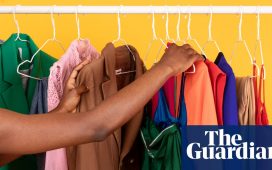Domestic abuse charity Women’s Aid has brought attention to a less-talked-about aspect of domestic violence with a new campaign.
Coercive control – defined broadly by the character as “pattern of behaviours used to control, manipulate or frighten another person” has been illegal since the end of 2015 but cases have been rising in recent years.
Some 24,856 offences of coercive control were reported between March 2019 and March 2020, an increase of roughly 8,000 from the year before.
And since the pandemic hit and lockdowns were put in place from March 2020 onwards, the safety of those in abusive relationships has become even more difficult to ensure. What’s more, between April 2020 and February 2021 calls and contacts logged on Refuge’s National Domestic Abuse Helpline went up by an average of 61%.
The campaign may look like your average fashion shoot, but with a real – and chilling – twist. Women are pictured in beautiful outfits, but where the credits for the brands they are wearing should be, the captions read something like “skirt – model’s partner” and “hair – model’s partner”, speaking to the control that abusive partners can have on someone’s everyday life.
“From the colour of the lipstick you wear, to what you think, say and do, living with a controlling partner means that your decisions are not always your own,” another caption from the photo shoot campaign reads. “Coercive control is as serious as physical abuse, which it’s why it’s against the law.”

The fact that you might miss what these captions are saying at first glance are a perfect way of expressing how signs of abuse can live beneath the surface, and it’s crucial that everyone looks out for them and is vigilant in calling them out. The aim of the campaign is to raise awareness of this less-known strand of domestic abuse, making it easier to identify and prosecute.
It’s important that we pay attention, as coercive control specifically is very difficult to identify as abusers who use it as a method can build up cases over time, and can result in emotional and mental scars instead of physical scars. In these cases, victims often become dependent on their perpetrator and doubt their own feelings on the situation, due to the manipulation involved.
Here are some key signs of coercive control, according to Women’s Aid:
- Isolating victims from family and friends
- Taking control of aspects of victims’ everyday life, such as where they go and what they wear
- Putting victims through humiliating and degrading behaviour

“By talking about coercive control to young women, we want to create awareness that means that abuse is recognised earlier, that it is understood that coercive control is a crime and that help is here from us at Women’s Aid if you need it,” Teresa Parker, head of media relations and communications at Women’s Aid says.
“Coercive control can be difficult to identify within a relationship, if you don’t know what the signs are,” Farah Nazeer, chief executive at Women’s Aid, adds. “A pattern of different forms of abuse with wide-ranging tactics can make it difficult to define, when you are being controlled and manipulated by a partner. Perpetrators slowly isolate survivors from support, deprive them of their independence and regulate their everyday behaviour, gaining more and more control.
“This campaign is vital in raising awareness of coercive control to help survivors, and those around them, recognise the signs of abuse. If any of the signs highlighted in this campaign are familiar to you, Women’s Aid is here for you – please reach out for expert support.”

We can’t ignore that the pandemic has made coercive control more of an issue. For instance, 66.7% of women who participated in a survey of domestic abuse survivors for Women’s Aid said that their abuser used Covid-19 and its restrictions as a tool of abuse. And seeing as we are by no means out of this pandemic 100%, the work needs to be done to ensure the safety of all.
During the Covid lockdowns, Women’s Aid introduced a Live Chat service, so that victims could seek help without having to speak out loud, seeing as they are likely to be around their abusers much more. However, the work doesn’t end there.
“We know that many women who have been in lockdown with their abusive partners will be experiencing trauma that we will only hear about in the coming months and even years,” Theresa says.
“It can take women a long time to leave an abusive partner, especially when they feel that they still love them and hope that they will change, or are too scared to leave. That is why it is so important to raise awareness, as the sooner you know that your experience ‘counts’ as abuse, the sooner you can reach out for support.”
For more information or advice, please visit Women’s Aid’s website or connect using their live chat.














